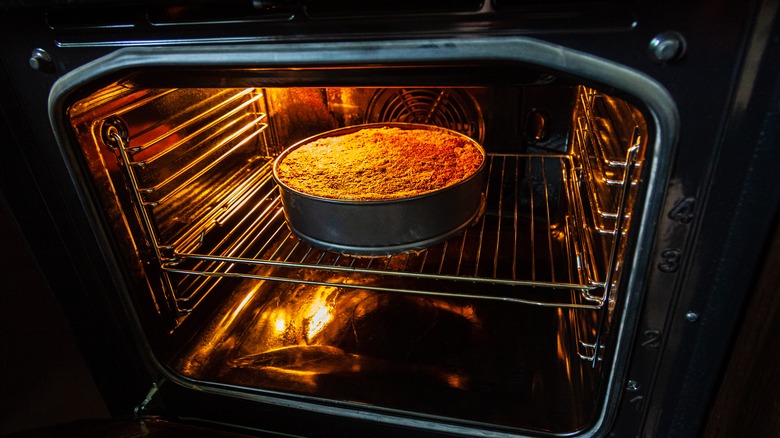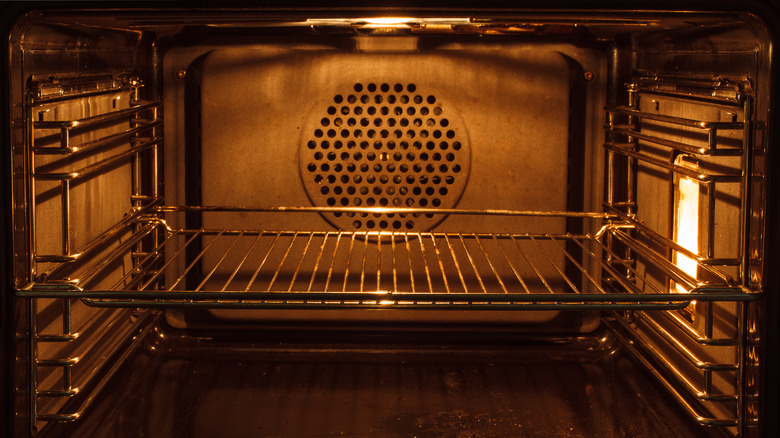Convection Oven Vs. Conventional: What's The Difference?
Ovens are essential to the kitchen. That obvious statement does not mean that ovens are standard, however. Ovens can be as simple as a few knobs or as complicated as a computer interface with 40 pre-sets. Ovens can be gas or electric; they can be large and commercial, small enough for a tiny apartment kitchen, or built into the wall. While there's an oven in most kitchens, there is no one type of oven in all.
Even if you have a simple oven, you'll need to get to know it. Like people, ovens have personalities. Hot spots, finicky burners, knobs that stick, alarms, settings, timers, and even self-cleaning functions. And what is that little button that says "convection"?
Pizza ovens notwithstanding, there are two types of ovens in kitchens across the globe — conventional and convection. Some conventional ovens have a convection option built in, while some convection ovens stand alone. The difference between the two is quite significant. Getting to know your oven will maximize its usefulness and help you execute any meal with ease.
Conventional ovens have a bottom heat source
Conventional ovens have only one heat source, explains Food & Wine. That heat source is either at the bottom or the top, but not both. If an oven has a heat source at the bottom, then the top is usually outfitted with a broiler, as MasterClass notes. Heat sources in these ovens work by heating the air inside the oven, but do not circulate it around the oven.
Ovens have a built-in thermostat, says ThermoBlog. So, once you set your oven to the desired temperature, the oven will stop heating until the temperature drops down again. Ovens with heat sources at the top have direct high heat that moves downward, while those with a bottom heat source have a radiant heat that moves upward naturally, according to Whirlpool. If you want a "neutral position" for the food you're cooking that's not too close to either heat source, then choose the middle rack. Obviously, food placed closer to the heating source will cook faster, warns MasterClass.
You may notice that many recipes call for rotating pans either top to bottom or back to front. This is to ensure even cooking, as a conventional oven does not circulate the heat evenly throughout, according to Bon Appéitit. Ovens like this are prone to developing hot spots that result in uneven baking, so the best way to avoid this is to rotate your pans when cooking.
Convection ovens circulate heat
Convection ovens use the same heat style as conventional ovens, with an internal thermometer and additional broiler, but they also have a built-in fan, writes Master Class. This oven's exhaust system circulates the hot air around the inside of the oven. Air circulation means that there are fewer hot spots, food cooks evenly, and all racks receive the same heat exposure, explains Whirlpool. Pan rotation isn't as necessary in a convection oven because every area is receiving heat, instead of being directed to one section, continues Master Class.
Air circulation also means that whatever you are cooking will take less time, writes Food & Wine. This is important to remember because unless a recipe says otherwise, most likely it's being written for a conventional oven, in which case you will need to adjust your baking temperature by 25 degrees.
If conventional ovens don't seem so conventional, there are a few instances where a convection oven may not be the better choice. Air circulation wicks away moisture, explains Master Class, resulting in dryer oven space. This is excellent if you want crispy skin on a whole turkey or crispy oven fries, but for soufflés, cheesecakes, and banana bread – dishes that rely on steam and moisture — a convection oven will dry them out.


